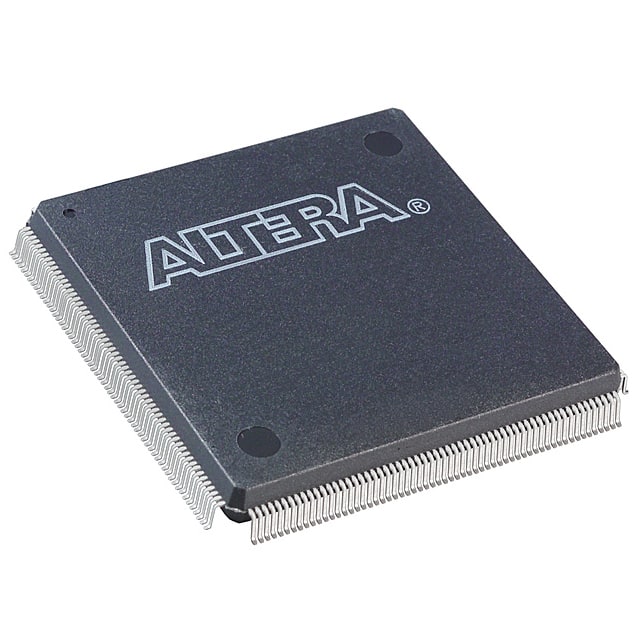EP1C6Q240C7
Product Overview
- Category: Programmable Logic Device (PLD)
- Use: EP1C6Q240C7 is a PLD used for digital logic design and implementation.
- Characteristics: It offers high performance, flexibility, and reconfigurability. It can be programmed to perform various functions based on user requirements.
- Package: The EP1C6Q240C7 comes in a compact package that ensures easy integration into electronic circuits.
- Essence: This PLD is designed to provide efficient and reliable digital logic processing capabilities.
- Packaging/Quantity: The EP1C6Q240C7 is typically sold in packages containing one unit.
Specifications
- Device Type: Programmable Logic Device
- Family: Cyclone
- Series: EP1C
- Number of Logic Elements: 6,000
- Number of Pins: 240
- Operating Voltage: 3.3V
- Speed Grade: C7
- Package Type: Quad Flat Pack (QFP)
Detailed Pin Configuration
The EP1C6Q240C7 has a total of 240 pins. The pin configuration is as follows:
- Pin 1: VCCIO
- Pin 2: GND
- Pin 3: TCK
- Pin 4: TMS
- Pin 5: TDI
- ...
- Pin 240: GND
For a complete pin configuration diagram, please refer to the manufacturer's datasheet.
Functional Features
- High-performance digital logic processing
- Reconfigurable design for flexibility
- Support for various input/output standards
- On-chip memory for data storage
- Built-in clock management circuitry
- Low power consumption
Advantages and Disadvantages
Advantages: - High performance and flexibility - Reconfigurable design allows for easy modifications - Support for various input/output standards enhances compatibility - On-chip memory reduces the need for external storage - Efficient clock management circuitry ensures accurate timing - Low power consumption helps conserve energy
Disadvantages: - Limited number of logic elements compared to higher-end PLDs - May require additional components for complex designs - Steeper learning curve for beginners due to its advanced features
Working Principles
The EP1C6Q240C7 operates based on the principles of digital logic. It consists of a network of configurable logic blocks (CLBs) interconnected through programmable interconnects. The device can be programmed using hardware description languages (HDLs) or graphical design tools to define the desired logic functions and interconnections.
Once programmed, the EP1C6Q240C7 executes the specified logic operations, processing input signals and generating output signals accordingly. The device's reconfigurability allows for easy modifications and updates to the logic design without requiring physical changes to the hardware.
Detailed Application Field Plans
The EP1C6Q240C7 finds applications in various fields, including:
- Embedded Systems: It can be used in embedded systems for controlling and managing peripheral devices.
- Communications: The PLD can be employed in communication systems for signal processing and protocol implementation.
- Industrial Automation: It can be utilized in industrial automation systems for control and monitoring purposes.
- Consumer Electronics: The EP1C6Q240C7 can be integrated into consumer electronic devices for enhanced functionality and performance.
- Automotive: It finds applications in automotive electronics for tasks such as engine control and driver assistance systems.
Alternative Models
- EP1C12Q240C8
- EP1C20Q240C6
- EP1C3T144C8
- EP1C4F324C8
- EP1C6F256C7
These alternative models offer similar functionality and performance to the EP1C6Q240C7, but with varying specifications and pin configurations. Users can choose the model that best suits their specific requirements.
Note: The content provided above is a sample structure for an encyclopedia entry on the EP1C6Q240C7 PLD. Additional information and details can be added as per the specific requirements of the encyclopedia.
기술 솔루션에 EP1C6Q240C7 적용과 관련된 10가지 일반적인 질문과 답변을 나열하세요.
Sure! Here are 10 common questions and answers related to the application of EP1C6Q240C7 in technical solutions:
1. What is EP1C6Q240C7? EP1C6Q240C7 is a field-programmable gate array (FPGA) manufactured by Intel. It is part of the Cyclone series and offers a range of features for implementing digital logic designs.
2. What are the key features of EP1C6Q240C7? Some key features of EP1C6Q240C7 include 6,000 logic elements, 240 user I/O pins, embedded memory blocks, PLLs for clock management, and support for various communication protocols.
3. What are the typical applications of EP1C6Q240C7? EP1C6Q240C7 can be used in a wide range of applications such as industrial automation, telecommunications, automotive systems, medical devices, video processing, and many more.
4. How can EP1C6Q240C7 be programmed? EP1C6Q240C7 can be programmed using hardware description languages (HDLs) such as VHDL or Verilog. The programming process involves writing code, synthesizing it, and then configuring the FPGA with the generated bitstream.
5. Can EP1C6Q240C7 be reprogrammed? Yes, EP1C6Q240C7 is a reprogrammable FPGA, which means that its configuration can be changed multiple times during its lifetime. This flexibility allows for iterative development and testing of different designs.
6. What tools are available for programming EP1C6Q240C7? Intel provides Quartus Prime software, which includes a suite of tools for designing, simulating, synthesizing, and programming FPGAs. Quartus Prime supports EP1C6Q240C7 and other Intel FPGA devices.
7. Can EP1C6Q240C7 interface with other components or devices? Yes, EP1C6Q240C7 has a variety of I/O pins that can be used to interface with other components or devices such as sensors, actuators, memory modules, communication interfaces, and more.
8. What are the power requirements for EP1C6Q240C7? EP1C6Q240C7 operates at a voltage range of 1.15V to 1.25V. The power consumption depends on the design and utilization of the FPGA, but it is typically in the range of a few watts.
9. Are there any limitations or considerations when using EP1C6Q240C7? Some considerations include the limited number of logic elements and I/O pins compared to higher-end FPGAs. Additionally, careful attention should be given to power management and thermal considerations.
10. Where can I find more information about EP1C6Q240C7? You can find more detailed information about EP1C6Q240C7, including datasheets, application notes, and reference designs, on the official Intel website or by referring to the documentation provided with the Quartus Prime software.


